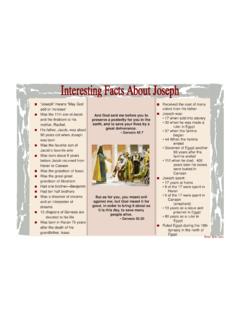Transcription of HISTORY - The Grand Folkestone/Home
1 Figures associated with the town included Henry James, joseph And the war to end it all Conrad, Noel Coward, Evelyn Waugh and Agatha Christie, and The Second World War had even more cataclysmic consequences. performers such as Robert Morley, David Tomlinson, Hattie Front Line Folkestone took a front line battering, and much of the Jacques, Michael Bentine, Michael Caine,Yehudi Menuhin, population, by then 50,000, was evacuated, leaving a rump of about Arthur Brough, Peter Bowles, Paul Nicholas and Nigel Havers. 10,000 for most of the six years of hostilities. Churchill and Montgomery (whose brother lived here) came, but Albert Sandler And their inventions The world's first pillar box was installed in 1858 opposite the site for Trinity Church, and the first telephone kiosk on The took his Palm Court Orchestra to Eastbourne, never to return.
2 Brain drain FOLKESTONE. Leas in 1903 opposite The Grand . Concrete achievements But worse was to come with the departure of the intelligentsia the town took a dive down market, and many of the fine old buildings HISTORY . were demolished, to be replaced by modern' constructions which in A local architect, Pope, had a brother with a cement works many cases are an assault on the sensibilities of the fashionable people on the East Cliff, the result of which was the earliest concrete who had formerly made the town their own. Lord Radnor's carriage houses being built on Marine Crescent in 1872, and the first drive Cherry Garden Avenue, laid out as the main dual carriageway steel and reinforced concrete building, The Grand , being entrance to the town in 1900 was mostly reduced to a single erected in 1899 through the initiative of Daniel Baker who carriageway.
3 Even major employers such as Pfizers were driven out became Mayor of Folkestone. the town clerk of the time, Noel Scragg, maintained that this was the crowning achievement of his career and Kent University was diverted Beauty, for all to see to Canterbury, all in the name of keeping employment costs down for Nettie Bainbridge was crowned here as the world's first the benefit of the tourist industry but which thereby lost a sizeable beauty queen in 1911, and John Logie Baird, who had a shop in chunk of its patronage. Guildhall Street, made the first television transmissions to John Stainer's shop in Sandgate Road in the 20s he another of the Rolls out town's mayors.
4 Folkestone had had the highest density of Rolls-Royces in the world per head of population; it even had two of its own R-R coachbuilders, Top level politicians to boot Maltby's and Martin Walter. The Parliamentary representatives for Folkestone & Hythe have included Sir Edward Watkin, Chairman of the South But it's still an historic royal domain Eastern Railway and architect of not only major harbour King John made Folkestone his headquarters for his pre 1215 Magna developments but also the early Channel tunnel schemes and a Carta discussions with the Papal Legate, and over the ensuing fast rail service to London.
5 Sir Philip Sassoon, ADC to Earl centuries Henry VIII, Elizabeth I,Victoria, Edward VII, Edward VIII and Haig of poppy fame, Minister for Air in the formative years of latterly Princess Margaret all stayed here, the last three in The Grand . aviation with his own airfield; socialite and bon vivant Sir Harry Mackeson, rather partial to his own Hythe brewery product; The future is arriving here and now! Sir Albert Costain, another master of concrete, whose firm The town's strategic location and idyllic environment is again coming built the motorway into Folkestone; and lately Michael Howard to the rescue aided by its adroit residents.
6 To service the Channel who was instrumental in putting Folkestone back on the map Tunnel not only has the road network been massively improved but particularly by soliciting the high speed rail link to London. also the railway infrastructure has been substantially upgraded; 100. years ago the best trains made London in a little over the hour (50%. The war to end all wars faster than lately), but now thanks to our resident recent MP we have Proximity to the Continent, however, was again to take its toll. trains to the capital in under an hour, and Paris in only about two.
7 During the First World War, Folkestone became the main transit camp for troop movements to the front line in Money again with style! northern France, and it is said that there were about ten Our home grown billionaire, the Saga sage Roger De Haan, is million troop embarkations here. However, the image of refurbishing many buildings in the Old Town and attracting occupants Fashionable Folkestone had taken a pasting, and after the for his Creative Quarter. Demand for good houses has accelerated, cessation of hostilities with high taxation and the decline in and in its wake is coming the patronage for stylish shops, restaurants spending power of the well to do the atmosphere became and other amenities which should help restore Folkestone to its rather more cosmopolitan.
8 Premier position as the jewel of the south coast. SYNOPSIS OF FOLKESTONE Blood money A famous son of Folkestone, Dr Wm Harvey, discovered that blood battle of Waterloo; he rushed to London, sold government consols short', the price crashed because it was thought he Past & Present circulated around the body, and became physician to the King nearly 400 years ago; he left the founding bequest for the town's Harvey knew the allies had lost before anyone else, but his agents quietly bought up all they could and when a British victory Grammar School. was promulgated the Rothschild banking fortune was secured.
9 Location location location! For many years one of the family lived in a fine mansion Napoleonic fortification on The Leas. Folkestone has been fashioned by its strategic location between The prospect of invasion loomed again 200 years ago when the England and the Continent, the development of communications French dictator Napoleon was eyeing up the Kent coast from across A harbour with a railway more money! and the foresight of its residents. the Channel. Massive fortifications were constructed in the The initial attempts at improving the harbour facilities had Roman cannon fodder Folkestone area primarily centred on Dover Castle, but with been fraught with difficulties, but help was at hand with the It first came to prominence in Roman times, 2000 years ago.
10 Martello Towers costing over 3000 each dotted along the Channel arrival of the South Eastern Railway in 1843 spanning the Caesar, who invaded in 55BC, is said to have built a fortification coastline and a fortified canal along the northern edge of Romney Foord Valley with still the highest brick arched viaduct in the on an escarpment to the north of the present town, on a round Marsh. The whole area became a vast military encampment, and world. This was primarily constructed to give a good topped hill, formerly an iron age fort, now known as Caesar's extensive road building was undertaken to ensure good and speedy connection between London and Paris initially via Dover.





